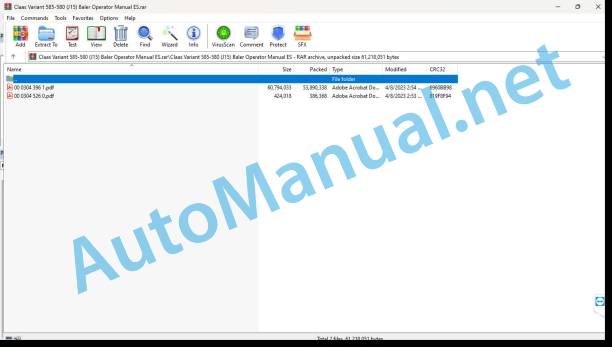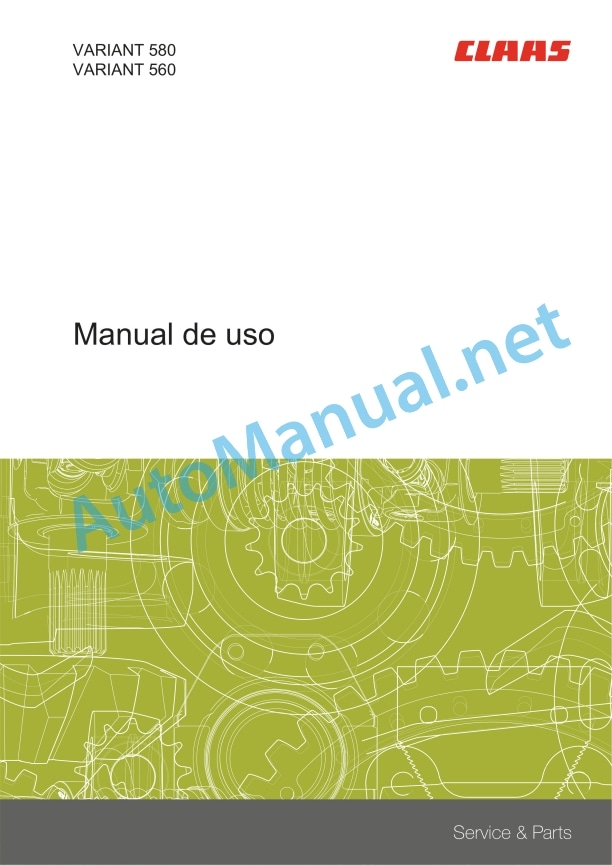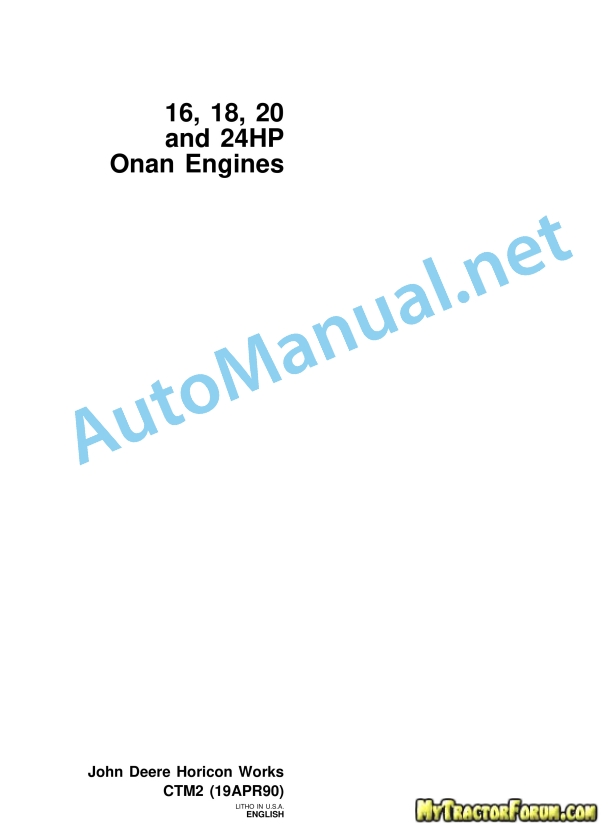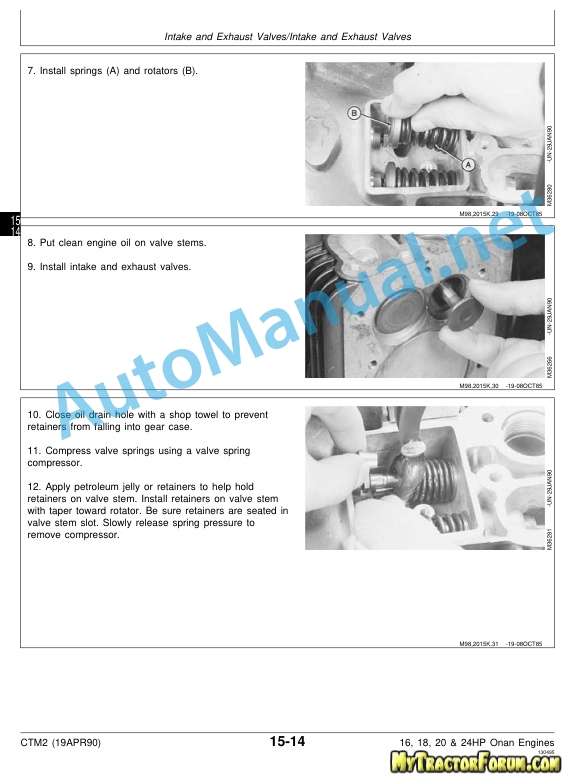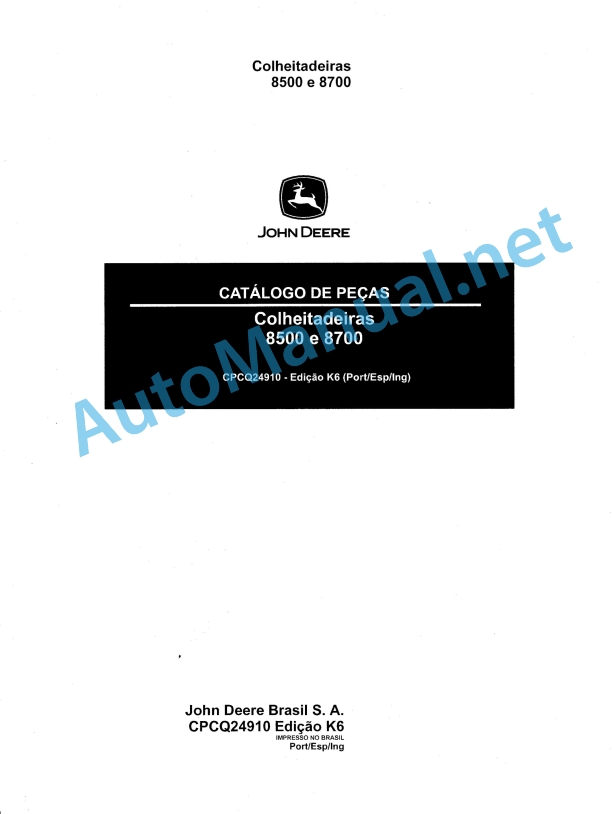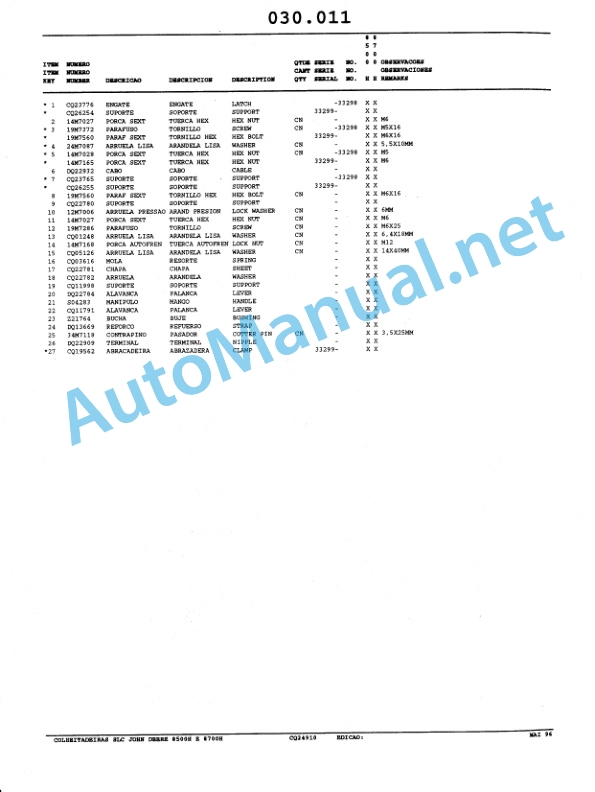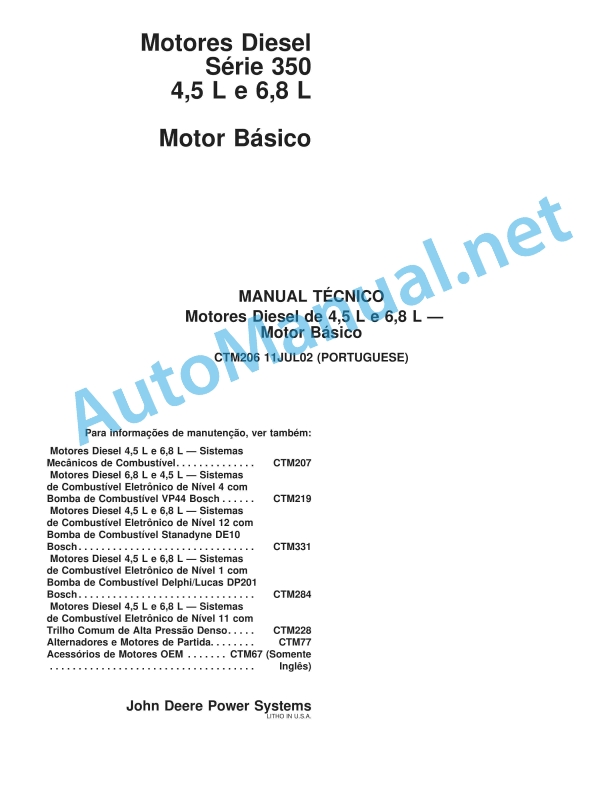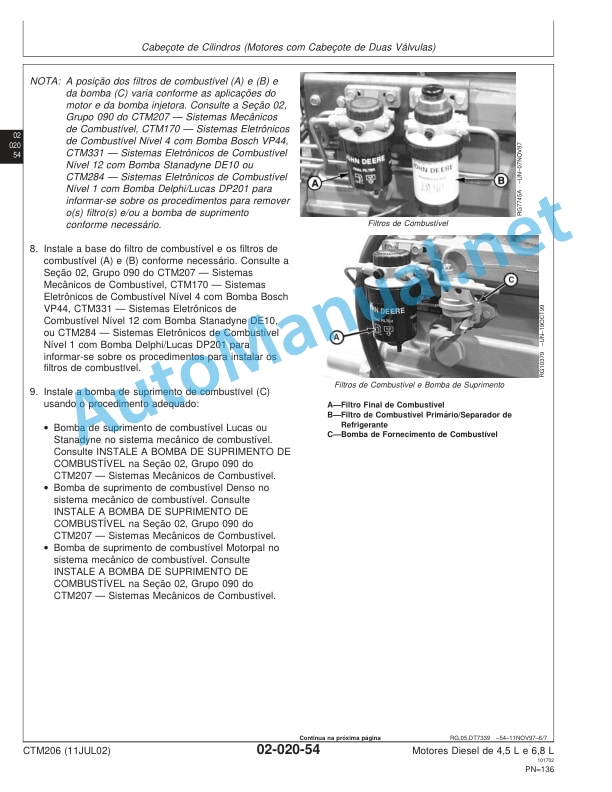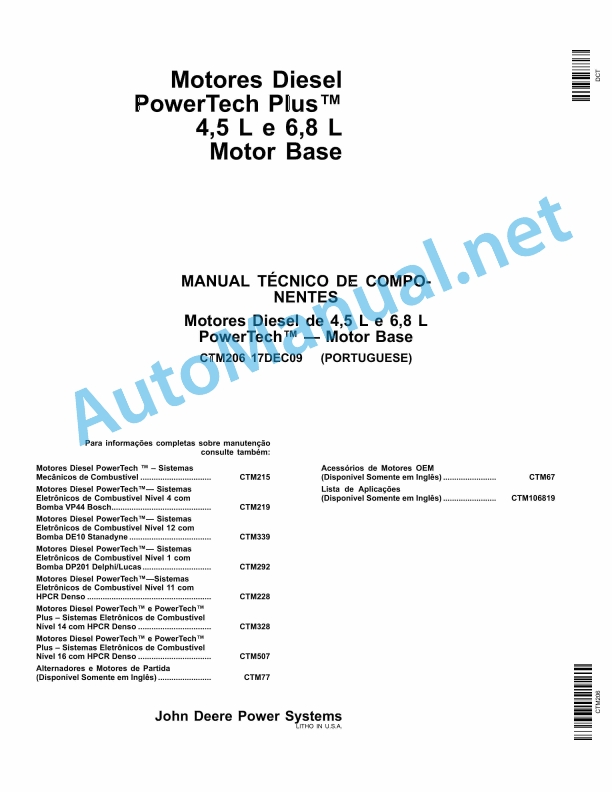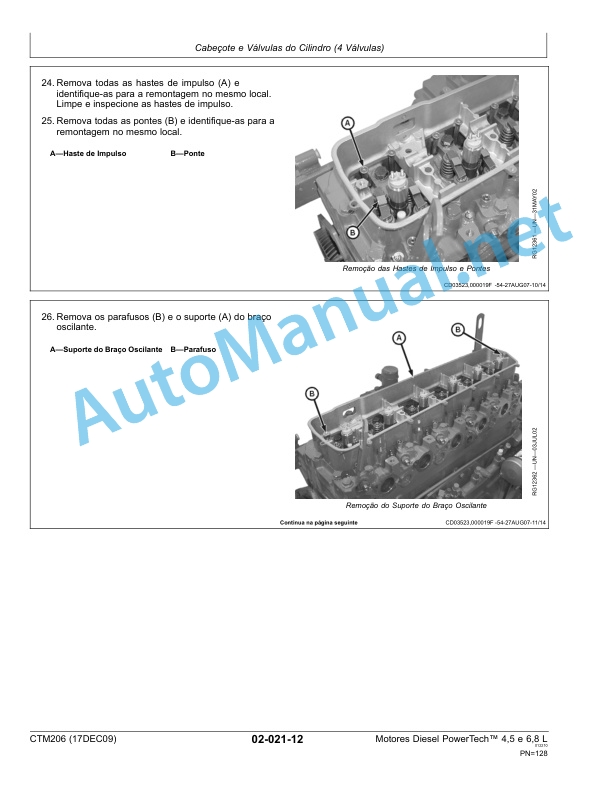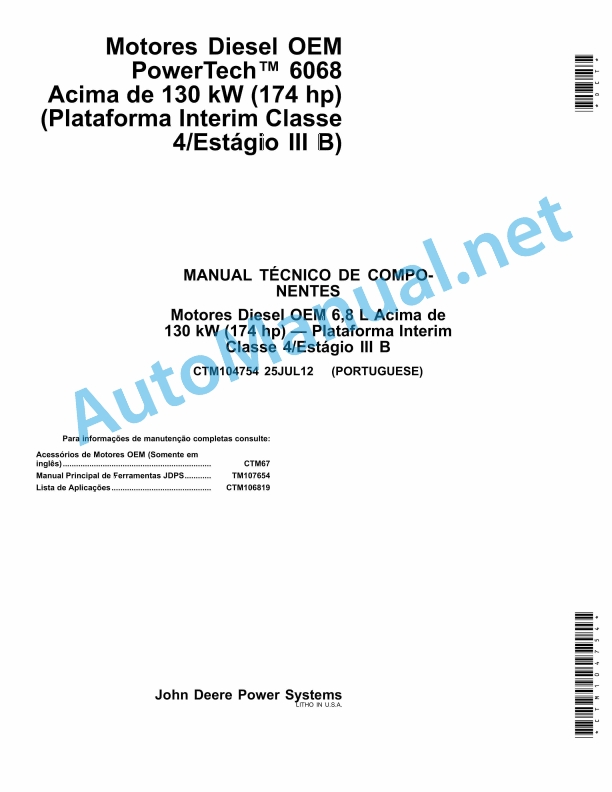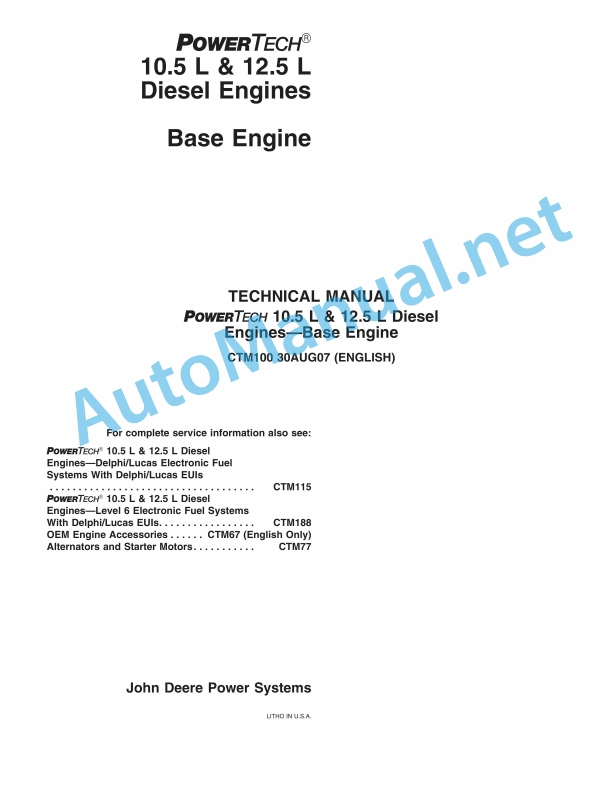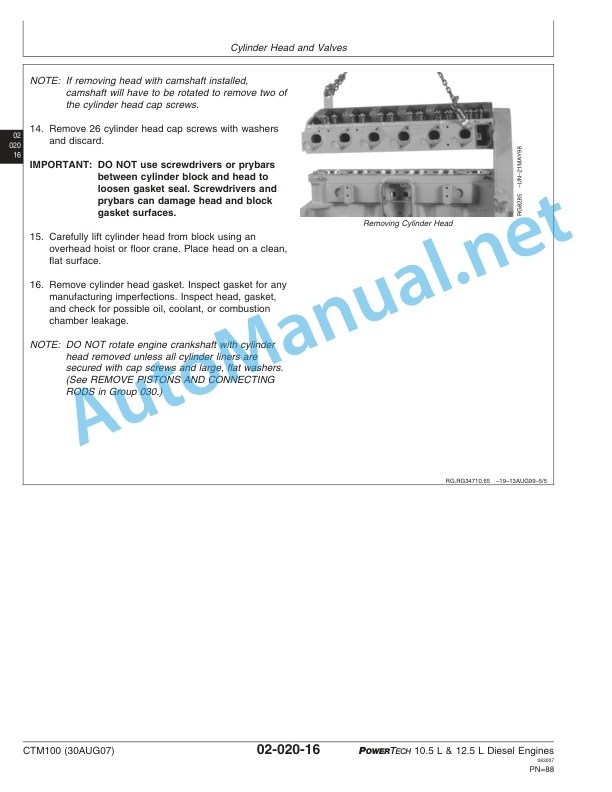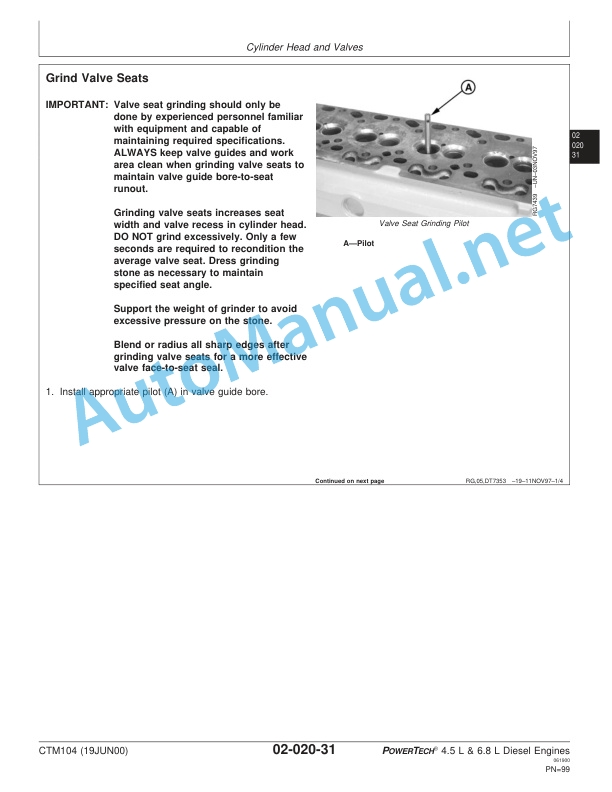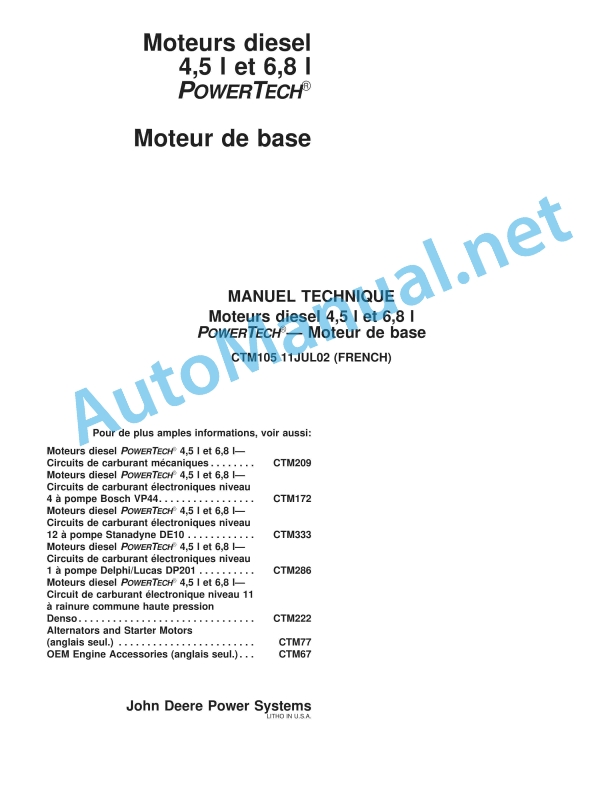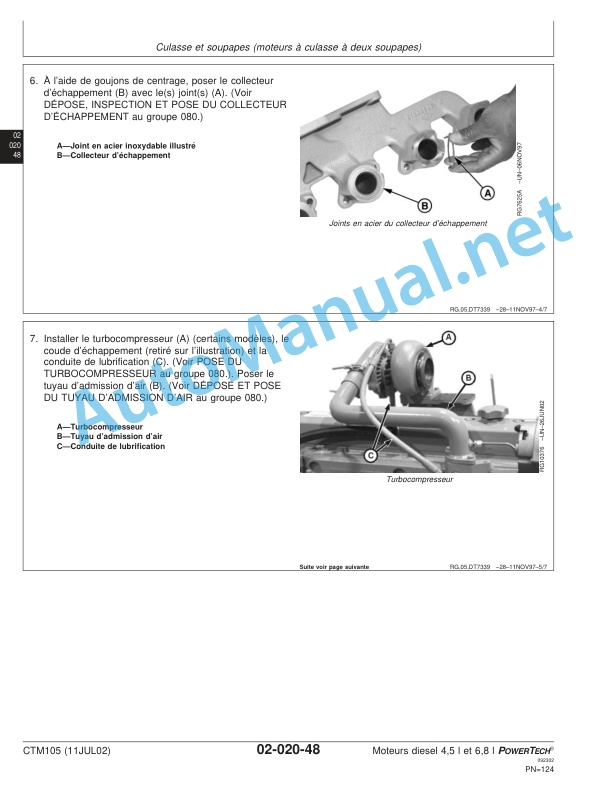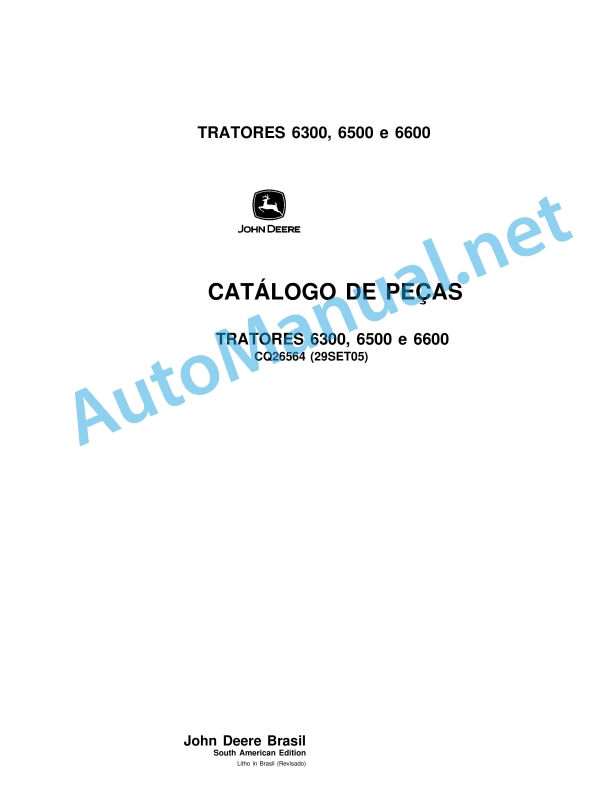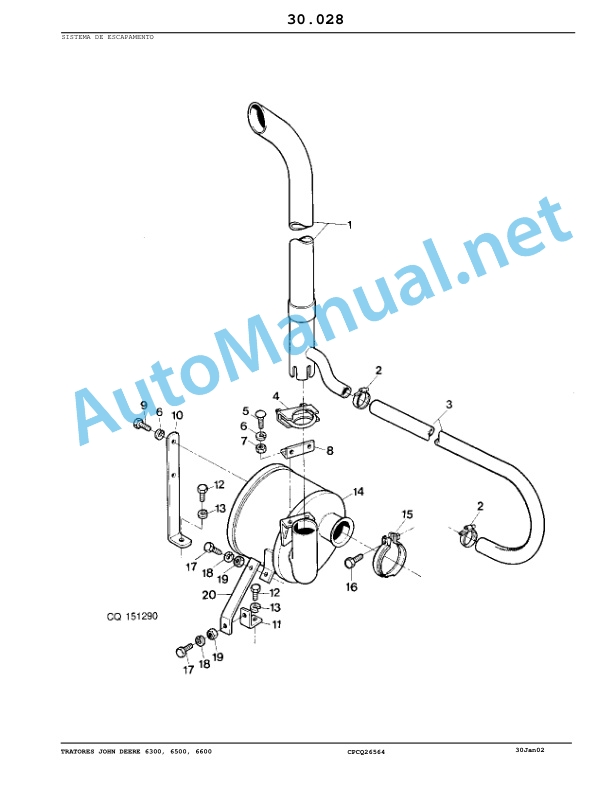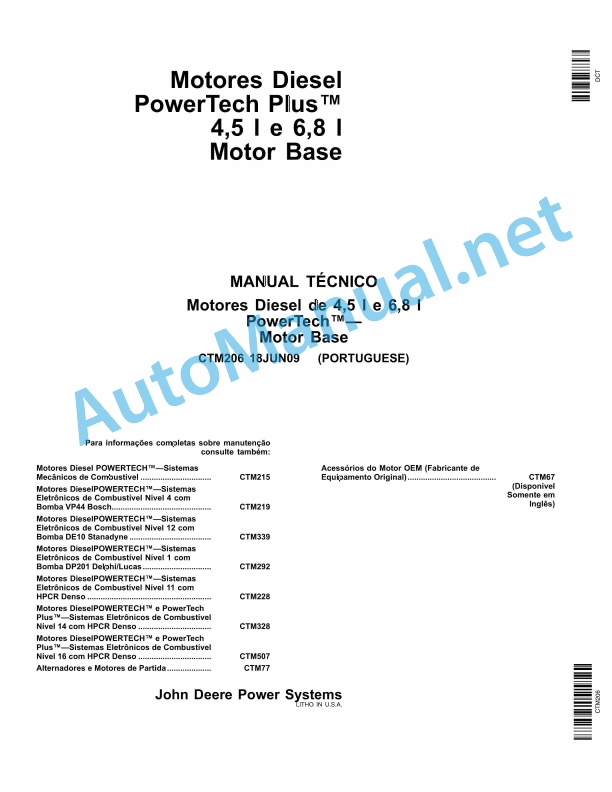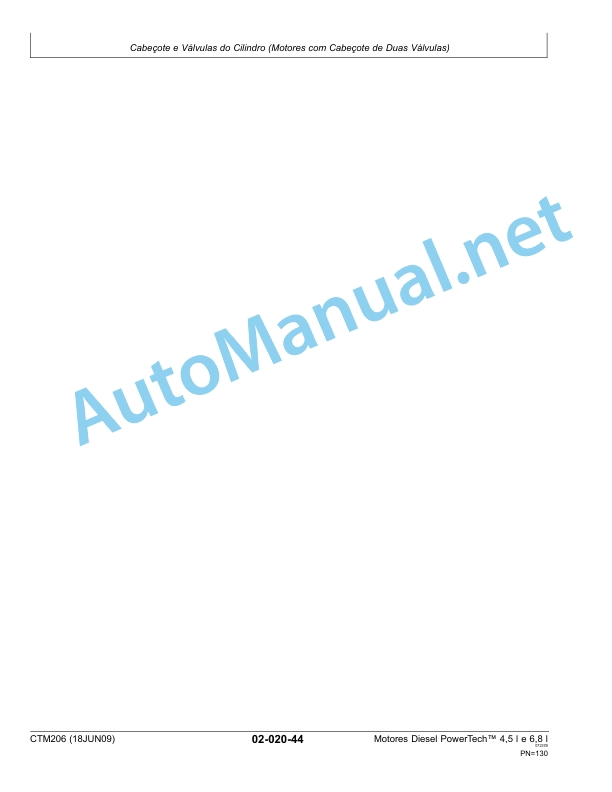Claas Variant 585-580 (J15) Baler Operator Manual ES
$50.00
- Model: Variant 585-580 (J15) Baler
- Type Of Manual: Operator Manual
- Language: ES
- Format: PDF(s)
- Size: 51.8 MB
File List:
00 0304 396 1.pdf
00 0304 526 0.pdf
00 0304 396 1.pdf:
User manual
1. Introduction
1.1 General information
1.1.1 Application of this manual
1.1.2 Information about this instruction manual
1.1.3 Symbols and indications
1.1.4 Optional equipment
1.1.5 Qualified specialized workshop
1.1.6 Maintenance instructions
1.1.7 Information regarding warranty
1.1.8 Spare parts and technical issues
1.2 Proper application of the machine
1.2.1 Authorized use
1.2.2 Reasonably foreseeable misuse
2 Security
2.1 Recognize warning signs
2.1.1 Danger symbols
2.1.2 Keyword
2.2 Safety instructions
2.2.1 Meaning of the instruction manual
2.2.2 Observe graphic danger symbols and alarm indications
2.2.3 Requirements for all people working with the machine
2.2.4 Children in danger
2.2.5 Dangerous areas
2.2.6 Position yourself between the tractor and the machine
2.2.7 Accompanying persons
2.2.8 Couple the tractor with the machine
2.2.9 Risk of injury due to rotating shafts
2.2.10 Construction modifications
2.2.11 Optional equipment and spare parts
2.2.12 Control of the tractor in operation
2.2.13 Use only after correct start-up
2.2.14 Technical status
2.2.15 Danger due to machine breakdowns
2.2.16 Comply with technical limit values
2.2.17 Danger due to coasting parts
2.2.18 Maintain functional protection devices
2.2.19 Personal protective equipment
2.2.20 Wear appropriate clothing
2.2.21 Remove dirt and loose objects
2.2.22 Prepare the machine for road traffic
2.2.23 Dangers when driving on the road and in the countryside
2.2.24 Park the machine safely
2.2.25 Parking without supervision
2.2.26 Consumables that do not meet the requirements
2.2.27 Safe handling of consumables and auxiliary materials
2.2.28 Environmental protection and waste disposal
2.2.29 Fire protection
2.2.30 Very dangerous electrical discharge from overhead power lines
2.2.31 Electrical shock from electrical equipment
2.2.32 Liquids under pressure
2.2.33 Pressurized air
2.2.34 Hot surfaces
2.2.35 Work only on the stopped machine
2.2.36 Maintenance work and repair work
2.2.37 Machine parts and lifted loads
2.2.38 Risks derived from welding work
2.3 Graphic danger symbols
2.3.1 Structure of graphic hazard symbols
2.3.2 Location of safety stickers
3 Machine Description
3.1 Existing models
3.1.1 Designation of machines
3.2 Overview and functions
3.2.1 Left side
3.2.2 Right side
3.2.3 Roller identification
3.3 Safety equipment
3.3.1 Signal lighting
3.3.2 Reflective equipment
Lateral reflectors
Clearance reflectors
3.3.3 Surety
3.3.4 Folding sear*
3.3.5 Wheel chocks
3.3.6 Holding cable*
3.3.7 Parking brake*
3.3.8 Tailgate lock
3.3.9 Locking the pick-up
3.3.10 Fire extinguisher*
3.3.11 Main box output protection*
3.4 Work and service positions
3.4.1 General information
3.4.2 Front of the baler
3.5 Identification plate and serial number
3.5.1 Spare parts and technical information
3.5.2 Identification number or VIN code
3.5.3 Machine identification plate
Identification plate for machines with European approval
Identification plate for machines without European approval
Identification plate for the countries of the Customs Union (Belarus, Kazakhstan, Russia)
Identification plate for North America
3.5.4 Axle identification plate
3.6 General operating principle
3.6.1 Bale pressing cycle
3.7 Machine information
3.7.1 Location of information stickers
3.8 Control terminal
3.8.1 CEMIS 700*
3.8.2 ISOBUS connection
3.9 Transmission and drive
3.9.1 Transmission
3.9.2 Drive
3.9.3 Drive Chains
3.9.4 Drive Chains
3.9.5 Pick-up drive
3.9.6 Rotor drive
3.10 Trailer support
3.10.1 Types of coupling
3.11 Harvest harvest
3.11.1 Pick-up
3.11.2 Pick-up wheels
3.11.3 Compactor
3.11.4 Short straw plate*
3.11.5 Reduction roller*
3.11.6 Double reduction roller*
3.12 Power supply unit
3.12.1 Rotor
3.12.2 Rotor frame with folding bottom*
3.12.3 Cutting device*
ROTO CUT*
ROTO CUT Heavy Duty (HD)*
Protection against foreign bodies
3.12.4 False blades*
3.13 Pressing system
3.13.1 Pressing chamber and belts
3.13.2 Loose core
3.13.3 Management of peripheral layers
3.13.4 Pressing chamber filling indicator*
3.13.5 Humidity sensor*
3.14 Tying system
3.14.1 Types of tying
3.14.2 Tying with thread
3.14.3 Tying with mesh
3.14.4 Bundling introduction plate
3.14.5 Tying process
3.14.6 Yarn/mesh box
3.15 Unloading bales
3.15.1 Bale unloading ramp
3.16 Lubrication system
3.16.1 Automatic chain lubrication
3.17 Greasing system
3.17.1 Manual centralized lubrication*
3.17.2 Electric automatic centralized lubrication*
3.18 Brake
3.18.1 Hydraulic braking
3.18.2 Pneumatic braking
3.19 Hydraulic system
3.19.1 Baler Hydraulic Block
Pressing chamber management
Rotor disengagement*
Feeding group management*
3.20 Equipment
3.20.1 Ladder
3.20.2 Stirrup
3.20.3 Modules
3.20.4 Anti-theft*
3.20.5 Working lighting*
3.20.6 Rear work light and camera*
4 Control and display instruments
4.1 CEMIS 700
4.1.1 Presentation
4.1.2 Description of the CEMIS 700
4.1.3 Description of the CEMIS 700
4.1.4 Description of the CEMIS 700
4.1.5 Description of the CEMIS 700
4.1.6 Description of the CEMIS 700
4.1.7 Description of the CEMIS 700
4.1.8 Description of the CEMIS 700
4.1.9 Description of the CEMIS 700
4.2 ISOBUS terminal
4.2.1 Presentation
4.2.2 General information
5 Technical data
5.1 Baler
5.1.1 Dimensions
5.1.2 Weight
5.1.3 Hookup
5.1.4 Cardan shaft
5.1.5 Pick-up
5.1.6 Power group
5.1.7 Pressing system
5.1.8 Tying device
5.1.9 Wheels
5.1.10 Hydraulic circuit
5.1.11 Screw tightening torques
5.1.12 Braking
5.1.13 Greasing and lubrication
5.1.14 Sound levels
5.2 Safety devices
5.2.1 Security screw
5.2.2 Torque limiter
5.3 Inputs
5.3.1 Lubricants
5.3.2 Tying thread
5.3.3 Tying mesh
5.4 Tractor
5.4.1 Required power
5.4.2 Maximum authorized mass of the towing vehicle
5.4.3 Hooking
5.4.4 PTO
5.4.5 Hydraulic circuit and oil
5.4.6 Electrical connections
5.4.7 Hydraulic connections
5.4.8 Braking
6 Preparation of the machine
6.1 Turn off the machine and secure it
6.1.1 Stop and secure the tractor and machine
6.2 Adapt the tractor
6.2.1 Check the tractor power take-off protection device
6.2.2 Adapt the tractor’s pneumatic brake equipment
6.2.3 CEMIS 700* assembly
6.2.4 Battery cable*
6.3 Adapt the machine
6.3.1 Recommendations
6.3.2 Handrail and upper protective screen
6.3.3 Adaptation of the hitch to the fork / hitch to the oscillating bar
Rudder arms
Rudder in low position
Rudder in high position
hitch device
6.3.4 Cardan shaft coupling
6.3.5 Adaptation of the cardan shaft length
6.3.6 Transformation kit, 8 grooves*
6.3.7 Reflective equipment*
Adjust the position of reflective equipment
6.4 Hooking up the machine
6.4.1 Holding cable*
6.4.2 Hitch fork
hitch lock
6.4.3 Cardan shaft safety regulations
6.4.4 Placing the cardan shaft
Gimbal support
Checking the steering angle
6.4.5 Identification of hydraulic hoses
6.4.6 Connection to the tractor hydraulic distributors
6.4.7 Hydraulic brake
6.4.8 Air brake
6.4.9 Identification of electrical cables
6.4.10 Lighting
6.4.11 Power supply to the baler and CEMIS 700*
6.4.12 Baler power supply with ISOBUS cable
6.4.13 Connect the camera*
6.5 Pick-up
6.5.1 Pick-up wheels
Folding pick-up wheels*
Change of position
6.5.2 Pick-up height
6.5.3 Simple reduction roller*
Single reducer roller suspension chain tension
Reducer roller position
Change of position
Compactor position
6.5.4 Double reduction roller*
Utilization
Position
Position
Double reducer roller height adjustment
Change of position
Work under normal conditions
Collection of large compact rows of straw
6.6 Tying with thread
6.6.1 Yarn quality
6.6.2 Preparation
6.6.3 Thread tensioner adjustment
6.6.4 Placing the coils
6.6.5 Thread passage
6.6.6 Selection of twine tying*
6.7 Tying with mesh
6.7.1 Mesh quality
6.7.2 Preparation
6.7.3 Mesh placement
6.7.4 Mesh brake adjustment*
Adjust mesh tension
6.7.5 Net tying selection*
6.8 Cutting device
6.8.1 Safety regulations
6.8.2 Control
6.8.3 Placing the blades (fixed bottom)
6.8.4 Placing the blades (folding bottom)
6.8.5 Placing the false blades*
6.8.6 Unused blades and false blades*
6.9 Unloading bales
6.9.1 General information
6.10 Load the machine
6.10.1 Baler stowage
6.10.2 Lifting points
Lifting points
6.10.3 Elevation
7 Management
7.1 General information
7.1.1 Baler user
7.1.2 Opening of hatches and crankcases
Side gates
Left pick-up crankcase
7.1.3 Raise/lower the pick-up
7.1.4 Activation / deactivation of the ROTO CUT blades*
7.1.5 Raising/lowering the folding bottom*
7.1.6 Opening/closing the tailgate
7.1.7 Mesh knife reset
manual reset
automatic reset
7.2 Movements with the baler
7.2.1 Equipment control
7.2.2 Preparations for transportation
7.2.3 Road travel
7.2.4 Arrival at the field
7.2.5 Moving around the field
7.2.6 Parking
7.3 Before each use
7.3.1 Reminders
7.3.2 Cardan shaft
7.3.3 Baler maintenance
7.3.4 Equipment control
7.3.5 Periods of intense heat
7.4 Commissioning in the field
7.4.1 Usage tips
7.4.2 Commissioning of the machine
7.5 Specific use
7.5.1 Use in silage – Normal conditions
7.5.2 Use in silage – Extreme conditions
7.5.3 Use in silage – Axle protection flange
7.5.4 Use with short material
7.6 Pick-up
7.6.1 Important
7.7 Power unit
7.7.1 Rotor frame with folding bottom*
7.8 Tied
7.8.1 Selection of tying with thread or mesh*
7.8.2 Setting the number of thread turns
7.8.3 Setting the number of mesh turns*
7.8.4 Changing the mesh roll
7.9 Bale parameters
7.9.1 General information
7.10 CEMIS 700
7.10.1 Display and navigation
7.10.2 Using the virtual keyboard
7.10.3 Setting bale parameters
Bale and loose core adjustments
bale diameter
Density of the outer layer of the bale
Bale diameter correction
Loose core management
Loose core diameter
Loose core density
Net Tying Adjustments*
Net tying time
Thread tying settings*
Thread tying time*
Alert time before obtaining the set bale diameter
Bale unloading ramp
Adjustment
7.10.4 Electronic bundling selection*
7.10.5 Pressing-tying process
7.10.6 Menu
7.10.7 Task name
7.10.8 Setting name
7.10.9 Pressing pressure
7.10.10 ROTO CUT* cutting device
7.10.11 Folding rotor bottom
7.10.12 Manual tying trigger
7.10.13 Tying delay
7.10.14 Pressing chamber filling indicator*
7.10.15 Bale moisture index indicator*
7.10.16 Rear work light*
7.10.17 Camera
7.10.18 Automatic lubrication*
7.10.19 Failures
7.10.20 DTC Failures
7.10.21 Failures
7.10.22 Monitoring of sensors and actuators
7.11 ISOBUS Terminal
7.11.1 General information
7.12 Unclogging the baler
7.12.1 How to avoid traffic jams?
7.12.2 Safety regulations
7.12.3 Unjamming the pick-up
7.12.4 Unclogging the baler with fixed bottom
7.12.5 Unclogging the baler with folding bottom
7.13 After use
7.13.1 Reminders
7.13.2 Securing the baler
7.13.3 Daily checks
7.13.4 Daily cleaning
7.14 Unhooking the machine
7.14.1 Holding cable*
7.14.2 Hitch fork
Hitch at rest
7.14.3 Baler release
cardan shaft
Guarantor
Electric connections
Hydraulic connections
8 Incident and solution
8.1 General information
8.1.1 Sensors
8.2 Hydraulic system
8.2.1 Hydraulic block
8.2.2 Pressing pressure faults
8.2.3 Rotor failures
8.2.4 Tailgate faults
8.2.5 Drive faults
8.3 CEMIS 700
8.3.1 DTC faults
8.3.2 Cutting depth*
8.3.3 Pressing pressure
8.3.4 Oversize
8.3.5 Unloading the bale
8.3.6 Tying with thread*
8.3.7 Tying with mesh
8.4 Tied
8.4.1 Tying with thread
8.4.2 Tying with mesh
8.5 Lubrication system
8.5.1 Origin of problems
8.5.2 Troubleshooting
8.6 Greasing system
8.6.1 Origin of problems
8.6.2 Lubrication failures
8.7 Other functions
8.7.1 General functions
9 Maintenance
9.1 General maintenance instructions
9.1.1 Maintenance and safety tips
9.1.2 Wheels and tires
9.1.3 Brakes
9.1.4 Hydraulic circuit
9.1.5 V-belt
9.1.6 Chains
9.1.7 Cardan shaft
9.1.8 Protection devices
9.1.9 Inductive sensors
9.2 Maintenance tables
9.2.1 Before harvest
9.2.2 After the first 10 hours of service
9.2.3 After the first 50 hours of service
9.2.4 Every 8 hours of service or daily
9.2.5 Every 50 hours of service
9.2.6 Every 100 hours of service
9.2.7 Every 250 hours of service
9.2.8 Every 500 hours of service or annually
9.3 Greasing scheme
9.3.1 Important
9.3.2 Greasing intervals
9.3.3 Greasing points – 8 h
9.3.4 Grease points – 50 h
9.3.5 Greasing points – 100 h
9.3.6 Grease points – 250 h
9.4 Gear maintenance operations
9.4.1 Transmission box 540 rpm
9.4.2 1000 rpm gearbox
9.4.3 Cardan shaft security screw
9.5 Axle and wheel maintenance operations
9.5.1 Wheel tightening check
9.5.2 Tire check
9.5.3 Lifting points
9.5.4 Replacing the wheels
9.5.5 Wheel hub
9.6 Brake maintenance operations
9.6.1 Hydraulic braking*
Checking the braking system
brake cylinder
braking lever
9.6.2 Pneumatic braking*
Checking the braking system
Circuit filtering
Cleaning the filters
Bleeding the compressed air tank
Checking the compressed air tank
braking lever
Pneumatic brake cylinder control
Safety brake
9.6.3 Replacing the brake linings
9.7 Hitch device maintenance operations
9.7.1 Fixing the hitch device and rudder
Checking the fixation of the rudder and hitch device
9.8 Hydraulic system maintenance operations
9.8.1 Hydraulic hoses
Laying of hoses
9.8.2 Filter
9.9 Pick-up maintenance operations
9.9.1 Pick-up
9.9.2 Pick-up security screw*
9.10 Maintenance operations on the power supply unit
9.10.1 Rotor clutch
9.11 Pressing chamber maintenance operations
9.11.1 Loosening the straps
9.11.2 Checking the wear of the lower tensioning arms
9.11.3 Belt wear control
9.11.4 Belt repair
9.11.5 Replacing a belt
9.11.6 Replacing a complete set
9.11.7 Centering of endless belts
If the straps are still incorrectly centered
If the straps are well centered
9.11.8 Roller #1
9.11.9 Roller #2
9.11.10 Roller #5
9.11.11 Roller #7
9.11.12 Drive springs
9.11.13 Clean the tailgate chain passage
9.11.14 Tailgate eccentric rings
9.12 Tying maintenance operations
9.12.1 Tying with thread
9.12.2 Tying with mesh
pinch roller
ratchet wheel
Mesh blade reset lever
Tying activation finger
9.12.3 Drive Belt Brake
9.12.4 Bundling introduction plate
9.12.5 Cleaning the tying system clutch
9.13 Bale unloading maintenance operations
9.13.1 Bale unloading ramp
9.14 Lubrication system maintenance operations
9.14.1 Chain lubrication
Oil pump sprocket set
9.15 Maintenance operations of the lubrication system
9.15.1 Manual lubrication
9.15.2 Manual centralized lubrication*
9.15.3 Electric automatic centralized lubrication*
Filling with filling pump with screw fitting
Filling with grease pump and grease fitting
Auxiliary centralized lubrication
Greasing frequency
Manual start of a centralized lubrication
Operation control
9.16 Bodywork maintenance operations
9.16.1 Side gates
9.16.2 Thread box
9.16.3 Fire extinguisher*
9.16.4 Inductive tailgate sensor
9.17 Hibernation
9.17.1 General information
9.17.2 Cleaning
9.17.3 Cleaning surfaces with stickers
9.17.4 Greasing
9.17.5 Maintenance
9.17.6 Storage
10 Decommissioning and waste disposal
10.1 General information
10.1.1 Decommissioning and waste disposal
11 EC declaration of conformity
11.1 VARIANT 560/580
11.1.1 Declaration of conformity for CE
John Deere Repair Technical Manual PDF
John Deere 16, 18, 20 and 24HP Onan Engines Component Technical Manual CTM2 (19APR90)
John Deere Parts Catalog PDF
John Deere Harvesters 8500 and 8700 Parts Catalog CPCQ24910 Spanish
John Deere Repair Technical Manual PDF
John Deere Repair Technical Manual PDF
John Deere Repair Technical Manual PDF
John Deere Repair Technical Manual PDF
John Deere Repair Technical Manual PDF
John Deere Repair Technical Manual PDF
John Deere Parts Catalog PDF
John Deere Tractors 6300, 6500, and 6600 Parts Catalog CQ26564 (29SET05) Portuguese
John Deere Repair Technical Manual PDF

